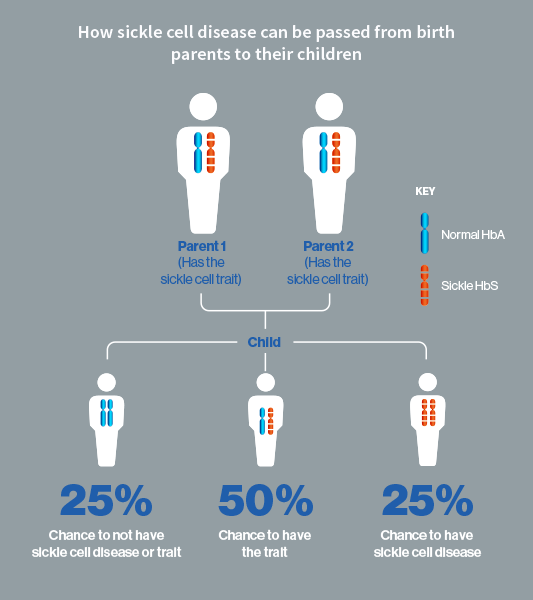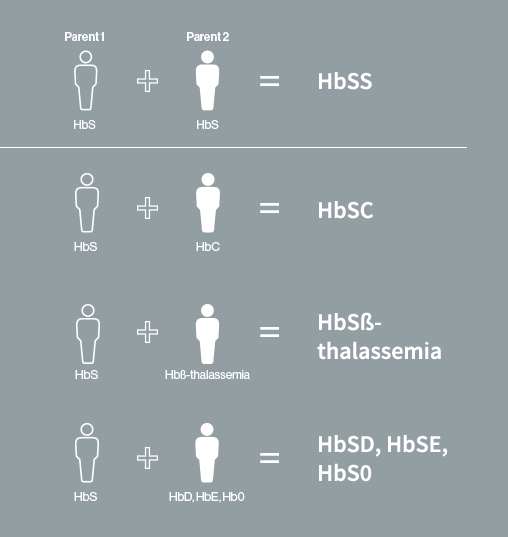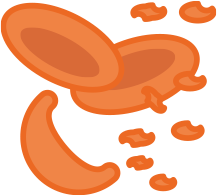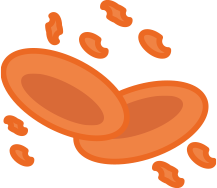
Understanding
sickle cell disease
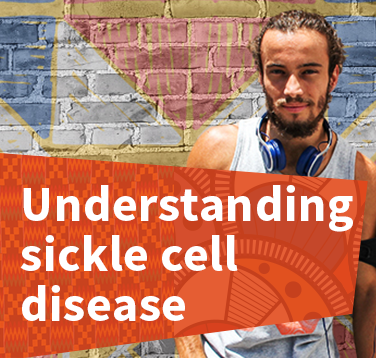
Sickle cell disease is an inherited blood disorder
Your body contains many sets of genes which you get from your birth parents. Each set plays a unique role in your body, such as determining your eye colour or skin tone. Another set of genes determines how red blood cells are made and how they work, which is not a feature you can see with your eyes. Those genes are called the haemoglobin [hee-muh-gloh-bin] genes, named after the protein in red blood cells that helps carry oxygen through your body.
You inherit one haemoglobin (Hb) gene from each parent. People who carry the sickle cell trait have one normal haemoglobin gene (HbA) and one sickle haemoglobin gene (HbS). HbS causes red blood cells to turn into a sickle shape. Having the sickle cell trait does not mean that someone has a “trace” sickle cell disease. It’s the opposite, actually. The sickle cell trait is completely separate from the disease; it may possibly cause symptoms, but instances of this are rare.
The risk of passing down sickle cell disease varies depending on whether each parent has the trait or if they have the disease. Each child that a couple has could potentially have sickle cell disease.
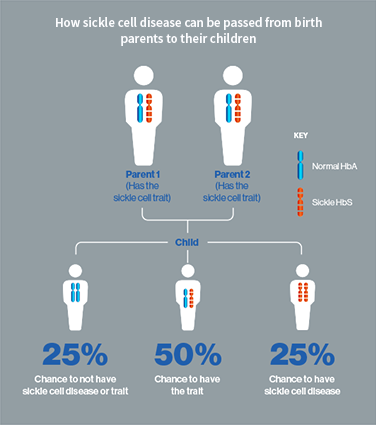
Your disease depends on the type of genes you have
Sickle cell disease actually refers to a group of different types of blood disorders caused by “sickle” haemoglobin (HbS). HbS is what all people with sickle cell disease have in common. However, there are different types of sickle cell disease. The specific type someone has depends on the kind of haemoglobin, beyond HbS, that you get from your birth parents.

When two birth parents have HbS, their child can have HbSS which happens to be the most common type of sickle cell disease worldwide.
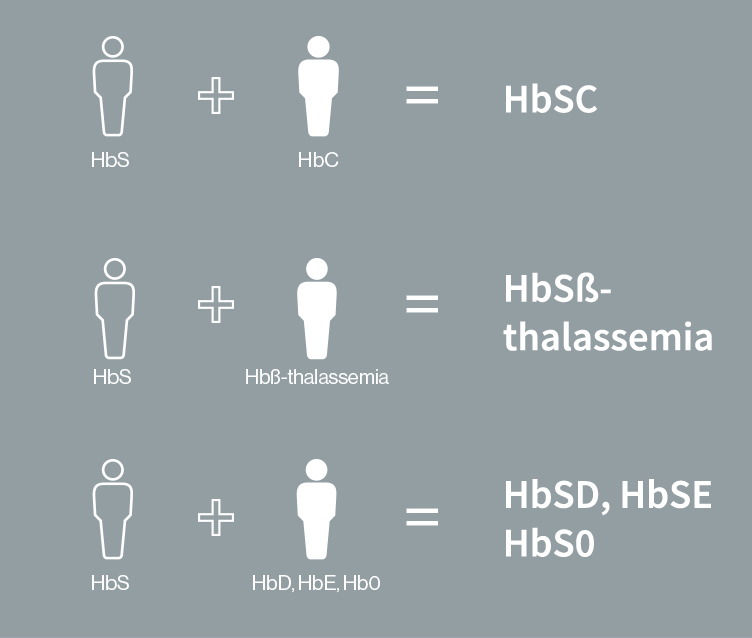
There are other possible changes to the haemoglobin gene which birth parents can also pass on to their children.
For example:
HbSC
HbS ß-thalassemia [thal-uh-see-mee-uh]
Like HbS, these genes limit how much oxygen red blood cells can carry through the body.
Any combination of HbS passed on with another haemoglobin gene, such as HbC and Hbß-thalassemia, can result in a child being born with sickle cell disease.
Sickle cell disease makes red blood cells less stable
The HbS gene causes red blood cells to become stiff and sickle shaped which affects the health of the cells. These unhealthy red blood cells break apart faster than healthy cells and it’s hard for the body to reproduce the blood cells it needs quickly enough. This creates a problem called anaemia which can make a person feel weak and tired.
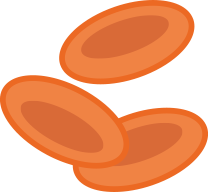
The disc shape helps red blood cells squeeze through small blood vessels without being damaged. By keeping their healthy disc shape, red blood cells can carry oxygen through the body.
What causes pain crises in sickle cell disease?
Sickle cell disease goes beyond red blood cells. The disease has an often silent, ongoing effect on blood vessels and other blood cells, too, such as white blood cells and platelets.
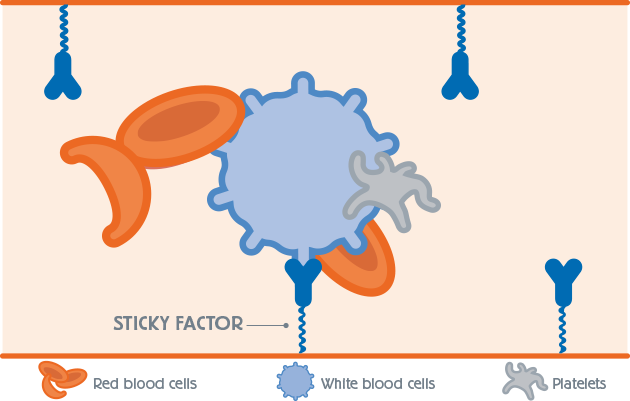
Stickiness
From an early age, sickle cell disease starts to damage and inflame the blood vessels. Damaged blood vessels become irritated and activate molecules in the blood called selectins [si-lekt-ins]. You can think of selectins as “sticky factors”. These sticky factors are what cause blood cells to stick to blood vessel walls and to each other.
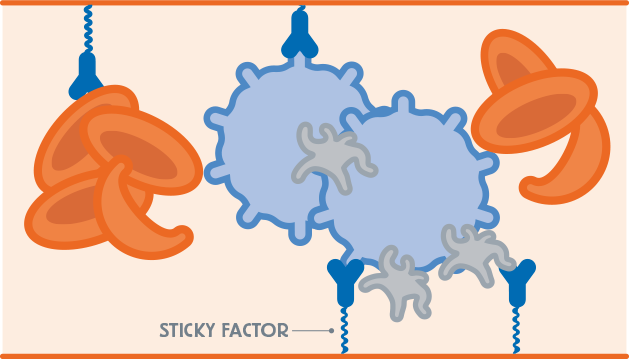
Clustering
As more and more blood cells interact with these "sticky factors", the cells get stuck to each other and to the vessel walls. This forms clusters in the bloodstream.

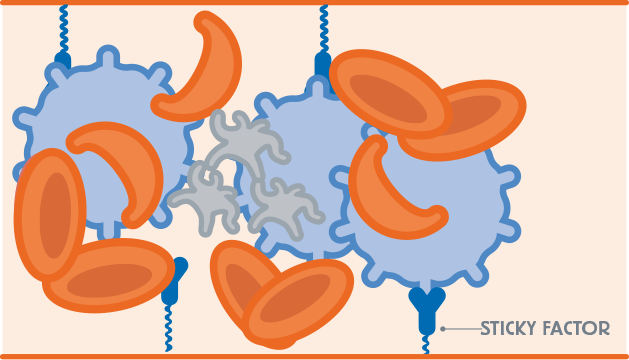
Blockages
The clusters build up and become blockages, making it difficult for blood and oxygen to flow normally. When you have sickle cell disease, the process of clusters forming and becoming blockages is ongoing.
![Your doctor may say vaso-occlusion [vey-soh uh-kloo-zhun]](./../assets/images/3_0/vaso-occlusion.png)
What is a pain crisis?

Blood cells stick to each other and blood vessel walls, forming clusters, in a process known as multicellular adhesion. When blood cell clusters get big enough, they can block blood and oxygen from flowing normally. The lack of oxygen in blood vessels can cause pain episodes, also known as pain crises.
The pain during a crisis can be severe and require medical attention. But often, people with sickle cell disease suffer at home, without seeking medical help and support. Over time, these frequent pain crises can make the condition worse. That is why it is important to keep track of pain crises and tell your health care provider about every pain crisis you or your child experience.




